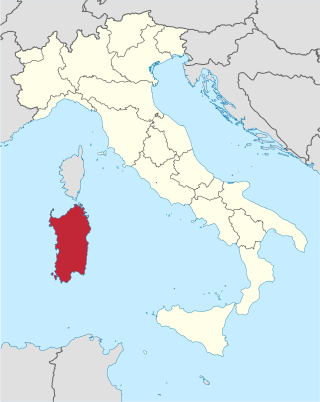
Sardinia is the second-largest island in the Mediterranean Sea, after Sicily, and one of the twenty regions of Italy. It is located west of the Italian Peninsula, north of Tunisia and immediately south of the French island of Corsica.

Archaeological evidence of prehistoric human settlement on the island of Sardinia is present in the form of nuraghes and other prehistoric monuments, which dot the land. The recorded history of Sardinia begins with its contacts with the various people who sought to dominate western Mediterranean trade in classical antiquity: Phoenicians, Punics and Romans. Initially under the political and economic alliance with the Phoenician cities, it was partly conquered by Carthage in the late 6th century BC and then entirely by Rome after the First Punic War. The island was included for centuries in the Roman province of Sardinia and Corsica, which would be incorporated into the diocese of Italia suburbicaria in 3rd and 7th centuries.
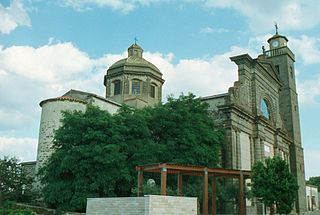
Abbasanta is a town and comune in the province of Oristano, Sardinia, Italy. It is on the main road between Macomer and Oristano.

The Judicates, in English also referred to as Sardinian Kingdoms, Sardinian Judgedoms or Judicatures, were independent states that took power in Sardinia in the Middle Ages, between the ninth and fifteenth centuries. They were sovereign states with summa potestas, each with a ruler called judge, with the powers of a king.

The province of Sassari is a province in the autonomous island region of Sardinia, Italy. Its capital is the city of Sassari. As of 2017, the province had a population of 493,357 inhabitants.

Tharros was an ancient city and former bishopric on the west coast of Sardinia, Italy.
Usellus is a town, comune (municipality) and former bishopric in the Province of Oristano in the Italian region Sardinia.

The Judicate of Arborea or the Kingdom of Arborea was one of the four independent judicates into which the island of Sardinia was divided in the Middle Ages. It occupied the central-west portion of the island, wedged between Logudoro to the north and east, Cagliari to the south and east, and the Mediterranean Sea to the west. To the northeast and beyond Logudoro was Gallura, with which Arborea had far less interaction. Arborea outlasted her neighbours, surviving well into the 15th century. At its greatest territorial extent it occupied the entire island except the cities of Alghero and Cagliari. The earliest known judicial seat was Tharros, though Oristano served as capital for most of its existence.

Scano di Montiferro is a comune (municipality) in the Province of Oristano in the Italian region Sardinia, located about 120 kilometres (75 mi) northwest of Cagliari and about 35 kilometres (22 mi) north of Oristano.
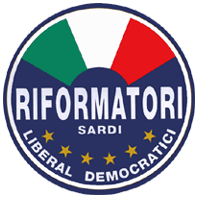
The Sardinian Reformers is a regionalist and liberal-conservative political party in Sardinia, led by Michele Cossa. The party, which has always been part of the centre-right at the Sardinian regional level, is a keen supporter of the free market, competition, globalization and a two-party system.
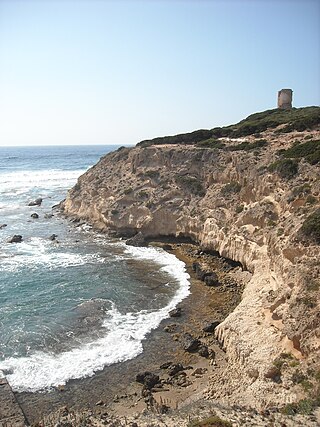
Capo Mannu is a promontory in Sardinia, Italy.

Sardinia is the second-largest island in the Mediterranean Sea and an autonomous region of Italy. Tourism in Sardinia is one of the fastest growing sectors of the regional economy. The island attracts more than a million tourists from both Italy, from the rest of Europe, and, to a lesser degree, from the rest of the world. According to statistics, tourist arrivals in 2016 were 2.9 million people.

Sardinian nationalism or also Sardism is a social, cultural and political movement in Sardinia calling for the self-determination of the Sardinian people in a context of national devolution, further autonomy in Italy, or even outright independence from the latter. It also promotes the protection of the island's environment and the preservation of its cultural heritage.

The Giants of Mont'e Prama are ancient stone sculptures created by the Nuragic civilization of Sardinia, Italy. Fragmented into numerous pieces, they were discovered in March 1974 on farmland near Mont'e Prama, in the comune of Cabras, province of Oristano, in central-western Sardinia. The statues are carved in local sandstone and their height varies between 2 and 2.5 meters.

Michela Murgia was an Italian novelist, playwright, and radio personality. She was a winner of the Premio Campiello, the Mondello International Literary Prize and Dessì prize, and was an active feminist and left-wing voice in the Italian public scene, speaking out on themes such as euthanasia and LGBTQ+ rights.

Hampsicora was a Sardo-Punic political leader and landowner of Sardinia, and the leader of the major anti-Roman revolt in the province of 215 BC.

The Byzantine age in Sardinian history conventionally begins with the island's reconquest by Justinian I in 534. This ended the Vandal dominion of the island after about 80 years. There was still a substantial continuity with the Roman phase at this time.
The Sardinian Cup, known as Coppa Italia Dilettanti Sardegna, or Coppa Sardegna in Italian, is an association football knock-out cup competition run by the Sardinian Committee of the Federazione Italiana Giuoco Calcio. Established in 1991-1992, it allows the winner to compete in the national phase of the Coppa Italia Dilettanti.

The Cathedral of Our Lady of the Snows is the main place of Roman Catholic worship in Nuoro, Sardinia, and the cathedral church of the diocese of Nuoro.
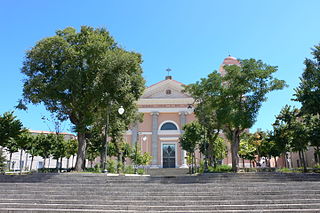
Frà Antonio Cano (1779–1840) was a sculptor, architect, and lay friar of the Kingdom of Sardinia.



















